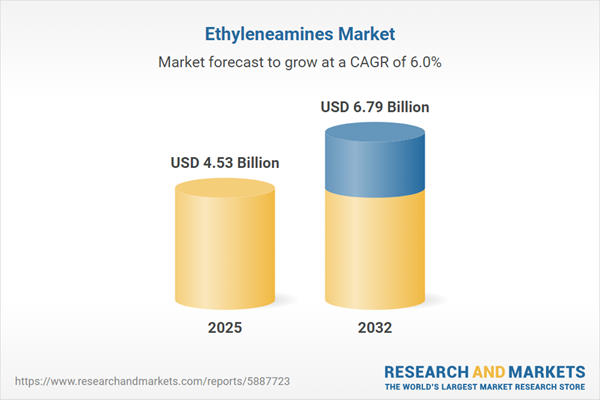Speak directly to the analyst to clarify any post sales queries you may have.
Ethyleneamines play a pivotal role in driving innovation and operational efficiency across a range of global industries. For senior decision-makers, a clear grasp of this specialty chemical market’s dynamics supports resilient strategies amid ongoing change.
Ethyleneamines Market Snapshot
The Ethyleneamines Market is demonstrating solid growth, reflected by an increase from USD 4.27 billion in 2024 to USD 4.53 billion in 2025 and a compound annual growth rate (CAGR) of 5.95%. This growth is driven by expanding application areas and increased adoption in both well-established and emerging sectors. Shifting supply chain models, evolving end-user needs, and rising competitive pressures require market participants to continuously align their capabilities with the market’s direction and maintain agility.
Scope & Segmentation of the Ethyleneamines Market
This report delivers targeted segmentation and actionable insights for executives shaping the future of their ethyleneamines operations. The following categories provide clarity on where opportunities, technologies, and risks are concentrated:
- Type: Diethylenetriamine, Ethylenediamine, Pentaethylenehexamine, and Triethylenetetramine each address specific functional requirements, offering diverse performance attributes that enable tailored applications and enhance compliance capabilities.
- Application: Uses span Adhesives & Sealants, Agrochemicals, Corrosion Inhibitors, Oilfield Chemicals, Polymerization, Surfactants, and Water Treatment; this underpins demand across sectors driven by the increasing need for durability, process optimization, and value-added innovation.
- End Use Industry: Agriculture, Automotive, Construction, Oil & Gas, and Water Treatment industries rely on ethyleneamines for operational efficiency, regulatory compliance, and advancement within supply and production environments.
- Region: The Americas, Europe, Middle East & Africa, and Asia-Pacific each present unique regulatory environments, market preferences, and growth prospects, requiring regionalized market approaches and customer engagement strategies.
- Key Companies: Major competitors include BASF SE, Huntsman Corporation, Evonik Industries AG, The Dow Chemical Company, Akzo Nobel N.V., Mitsubishi Gas Chemical Company, Inc., Nippon Shokubai Co., Ltd., Sumitomo Chemical Company, Ltd., China Petroleum & Chemical Corporation, and Wanhua Chemical Group Co., Ltd. Benchmarking processes against these leaders helps drive innovation, inform partnership potential, and set industry standards.
Understanding this segmentation assists executives in monitoring demand shifts, anticipating risks, and identifying emerging opportunities that shape the ethyleneamines value chain.
Key Takeaways for Strategic Decision-Makers
- Ethyleneamines underpin the enhancement of material performance for demanding sectors such as automotive, construction, and oilfield chemicals, where reliability and longevity drive competitive value.
- Ongoing investment in manufacturing technology, including digital process monitoring and optimization, is supporting improved operational efficiency and sustainability outcomes across production lines.
- Adoption of sustainable production practices—like sourcing bio-based feedstocks and implementing closed-loop systems—is responding to further regulatory and customer scrutiny, particularly in agriculture and water management sectors.
- Diversifying product portfolios to serve specialized niches helps manage supply risk and opens doors to high-value opportunities beyond traditional end uses.
- International and regional supplier collaboration is critical for ensuring supply stability, accelerating innovation, and supporting regulatory alignment in competitive markets.
Tariff Impact and Supply Chain Strategies
The introduction of recent US tariffs on precursor chemicals and finished amines has shifted sourcing patterns for downstream users, emphasizing local and regional supply options. North American producers are increasing output to meet revised demand, which raises competition for key feedstocks. As a result, companies are auditing procurement processes, renegotiating supplier contracts, managing inventory more proactively, and broadening supplier bases to buffer against policy changes. These steps are essential for cost competitiveness and business continuity within a changing regulatory setting.
Methodology & Data Sources
This analysis leverages direct executive interviews, expert technical insights, and feedback from key supply chain participants to reflect current market realities. Verified data from regulatory submissions, industry association reports, and peer-reviewed research further enhance the report’s relevance for senior leaders in the sector.
Why This Report Matters for Senior Leaders
- Keeps executive planning tightly aligned with evolving trends in ethyleneamines, incorporating market, compliance, and supply chain changes.
- Provides in-depth segmentation and up-to-date benchmarking to strengthen risk management and illuminate competitive positioning across major regions.
- Deciphers the strategic impact of trade policy and regional shifts, giving leaders the clarity needed to plan effectively for compliance and expansion.
Conclusion
Success in the ethyleneamines sector relies on proactive innovation, flexible supply strategies, and data-driven executive decision-making. Businesses that respond promptly to sector developments set themselves apart within an evolving marketplace.
Additional Product Information:
- Purchase of this report includes 1 year online access with quarterly updates.
- This report can be updated on request. Please contact our Customer Experience team using the Ask a Question widget on our website.
Table of Contents
3. Executive Summary
4. Market Overview
7. Cumulative Impact of Artificial Intelligence 2025
List of Figures
Samples

LOADING...
Companies Mentioned
The key companies profiled in this Ethyleneamines market report include:- BASF SE
- Huntsman Corporation
- Evonik Industries AG
- The Dow Chemical Company
- Akzo Nobel N.V.
- Mitsubishi Gas Chemical Company, Inc.
- Nippon Shokubai Co., Ltd.
- Sumitomo Chemical Company, Ltd.
- China Petroleum & Chemical Corporation
- Wanhua Chemical Group Co., Ltd.
Table Information
| Report Attribute | Details |
|---|---|
| No. of Pages | 181 |
| Published | October 2025 |
| Forecast Period | 2025 - 2032 |
| Estimated Market Value ( USD | $ 4.53 Billion |
| Forecasted Market Value ( USD | $ 6.79 Billion |
| Compound Annual Growth Rate | 5.9% |
| Regions Covered | Global |
| No. of Companies Mentioned | 11 |









